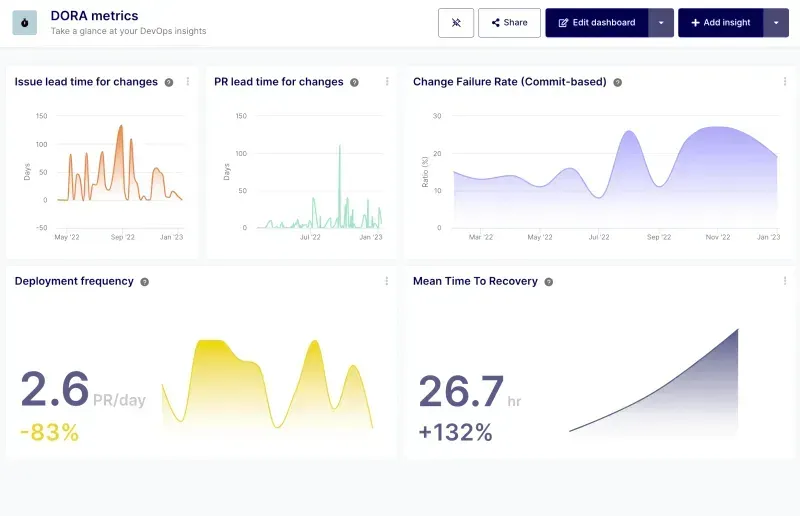What Are Git Reporting Tools?


Git reporting tools are essential for tech leaders who want to gain insights into their Git repositories and improve their team's development processes. These tools provide valuable information on a repository's history, changes, contributors, and overall status, helping tech leaders to make informed decisions and optimize their workflows. By using Git reporting tools, tech leads can generate reports and metrics that provide visibility into their team's work and identify areas for improvement.
Some popular Git reporting tools include:
Keypup – Beyond Git analytics, Keypup provides valuable reports and metrics and facilitates cross-stack real-time analytics by linking issues to pull request data. With Keypup, tech leaders and software development agencies can unify metadata extracted from multiple Git repositories and project management tools in real-time and access a variety of widely used customizable templates such as DORA metrics (DevOps Research and Assessment), Value Stream Management, and more.

GitStats – GitStats is an open-source statistics generator that provides detailed statistics about the repository, including the number of commits, contributors, files, and lines of code.
Gitinspector – Gitinspector is another open-source tool that generates detailed reports about the repository, including the number of commits, lines of code, and number of contributors. It also provides insights into the code quality by analyzing the code's complexity and churn rate.
Git-Cola – Git-Cola is a powerful Git client that provides a range of reporting and visualization tools. It allows developers to view the repository's history, branches, and tags, and provides graphical representations of the repository's activity and changes.
Keen – Keen is an open-source tool for analyzing and visualizing data from GitHub repositories. It helps users track and analyze various metrics such as pull requests, issues, commits, and contributors. Keen provides customizable dashboards, reports, and charts that enable users to gain insights into their team's productivity and performance. It also allows users to filter data based on various parameters and compare different metrics over time.
Git reporting tools can help tech leaders and technical organizations track important software development metrics. DORA metrics provide insights into how well a team is performing and help identify areas that need improvement. DORA metrics are a good way to get started with Git reporting without overwhelming the team with too many measurements. These metrics include:
By tracking these metrics, tech leaders and technical organizations can gain insights into their team's performance and identify areas for improvement, helping them to deliver software and value to their customers more efficiently and effectively.
Businesses like Google or Amazon use Git metrics such as DORA to continuously improve their software delivery pipeline and achieve high levels of product reliability and availability. By measuring key metrics, they can identify areas of improvement in their development processes and make data-driven decisions to optimize their pipeline. For instance, if a business has a high change failure rate, it can identify root causes and take corrective actions to improve code quality. Similarly, a high lead time for changes can indicate bottlenecks in the workflow that need streamlining. Some common bottlenecks in the development process include:

Identifying process bottlenecks and implementing strategies to solve them can lead to a more efficient and effective software delivery pipeline and an improved product reliability and availability. Git reporting tools can help tech leaders and organizations visualize these metrics and continuously improve their development processes to stay competitive in today's fast-paced technology landscape.
Monitoring and benchmarking team performance is essential for tech leaders to understand how their teams are functioning, identify areas of improvement, and establish targets for future progress. By monitoring team performance, leaders can analyze various metrics to gain insights into the efficiency of their development processes.
Benchmarking is crucial because it helps tech leaders to compare their team's performance with each other and with industry standards and competitors. This comparison allows them to identify where each team performs and where they stand in relation to the rest of the industry to identify any performance gaps. By setting benchmarks, leaders can develop strategies to improve a team’s performance and achieve desired results.
For example, let's say a tech leader wants to improve their team's deployment frequency to enhance their software delivery pipeline. They can benchmark their current deployment frequency against industry standards to identify areas of improvement. After identifying the bottleneck, the leader can analyze the reasons for the low frequency, whether it's a lack of automation, an inefficient workflow, or other issues. The leader can then create a plan to address the bottleneck and set a target for improving deployment frequency in the future.
Monitoring team performance and benchmarking against industry standards also provides several benefits, such as:


Tech leaders should avoid solely monitoring individual performance because it can create a toxic work environment that discourages collaboration and innovation. When employees are constantly under surveillance, they may become focused on pleasing their boss rather than working toward the team's goals. This can lead to a lack of trust between team members and cause resentment toward leadership.
Instead, tech leaders should empower their team members to monitor their own performance and hold themselves accountable. By encouraging a culture of transparency and continuous improvement, employees can identify areas for growth and take ownership of their work. This creates a more collaborative and supportive environment, where team members feel empowered to share knowledge, ideas, and best practices.
Furthermore, it is essential for tech leaders to focus on team performance rather than individual performance. This allows the team to work cohesively toward a common goal and prioritize collaboration over competition. By setting targets and benchmarks for the team, tech leaders can encourage collaboration and create an environment that values team success over individual success.

The ability to create custom reports is critical for tech leaders because it allows them to tailor their reporting to the specific needs of their organization. Custom reports can provide insights and metrics that are relevant to the specific goals and objectives of the organization, rather than using generic, one-size-fits-all reports.
Custom reports also allow tech leaders to visualize their data in ways that are more meaningful and impactful for their teams. They can customize the visualizations to highlight specific metrics, trends, or outliers that are important for their teams to understand. This can help teams identify areas of improvement, track progress toward goals, and make data-driven decisions to optimize their processes.
In addition, custom reports can also help tech leaders communicate their team's performance and progress to stakeholders outside of the technical team. By presenting data in a clear and concise way, tech leaders can help stakeholders understand the value and impact of the team's work and make informed decisions about future investments and resource allocation.

Automated and real-time Git reporting is critical for tech leaders because it allows them to stay up-to-date with their team's performance and make data-driven decisions quickly. With automated reporting, tech leaders can avoid the tedious and time-consuming task of manually collecting and analyzing data from multiple sources, which can be error-prone and may result in inaccurate reports. By having data automatically pulled and processed into reports, tech leaders can save time, improve accuracy, and make better decisions based on up-to-date information.
Real-time reporting is also essential as it provides leaders with immediate feedback on their team's performance. This allows them to identify potential issues or areas of improvement quickly and address them before they become major problems. Real-time reporting also enables tech leaders to track progress toward their goals and adjust their strategies accordingly.
Manual reporting can be time-consuming and often involves jumping from one tool to another to collect data. This can be frustrating and distracting for tech leaders who need to focus on strategic decision-making. By automating reporting, tech leaders can streamline their workflows and avoid the hassle of manual data collection and analysis. This, in turn, allows them to spend more time analyzing the data and making informed decisions based on the insights provided by the reports.
Git reporting tools and metrics like DORA help tech leaders gain valuable insights into their team's performance and make data-driven decisions to optimize their software delivery pipeline. By identifying areas of improvement in their development processes, tech leaders can set targets for their teams and track their progress over time.
Custom reports can be created to focus on specific metrics that are relevant to a particular team's goals or challenges. This allows tech leaders to tailor their reporting to the needs of their team and organization. Additionally, automating the reporting process in real time saves time and eliminates the risk of errors that can occur with manual reporting.

By forecasting team progress and product roadmap, tech leaders can better allocate resources and make informed decisions about the direction of their projects. This can help them stay ahead of the competition and deliver high-quality products to their customers on time. Start monitoring DORA metrics today and improve your overall performance.